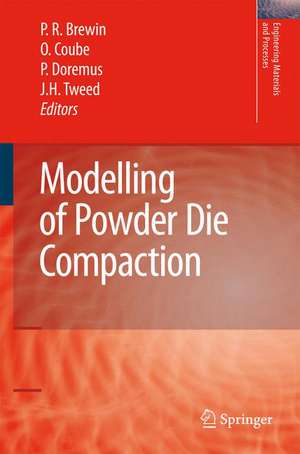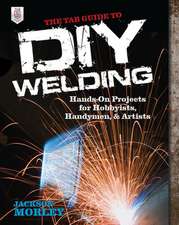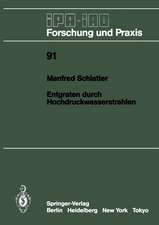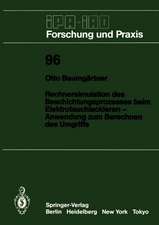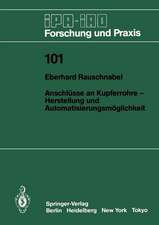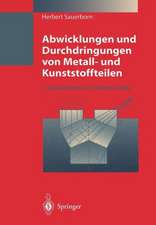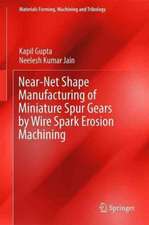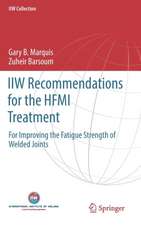Modelling of Powder Die Compaction: Engineering Materials and Processes
Editat de Peter R. Brewin, Olivier Coube, Pierre Doremus, James Hayward Tweeden Limba Engleză Hardback – 2 oct 2007
Modelling of the process of die compaction has been the subject of recent collaborative research from leading experts in Europe and this book presents a summary of the state of the art, taking examples from recent world-class research. Case studies are presented, providing a reference for the testing and validation of these compaction models.
The reader will learn about the: Industry requirements for models of die compaction; Techniques to generate the material data required for input to these models; Production and assessment of compacts for comparison with model predictions; Range of compaction models and results from exercises comparing these models with real powder compacts; The range of potential uses of these models in industry.
| Toate formatele și edițiile | Preț | Express |
|---|---|---|
| Paperback (1) | 947.18 lei 6-8 săpt. | |
| SPRINGER LONDON – 22 oct 2010 | 947.18 lei 6-8 săpt. | |
| Hardback (1) | 955.56 lei 6-8 săpt. | |
| SPRINGER LONDON – 2 oct 2007 | 955.56 lei 6-8 săpt. |
Din seria Engineering Materials and Processes
-
 Preț: 397.54 lei
Preț: 397.54 lei - 18%
 Preț: 1237.93 lei
Preț: 1237.93 lei - 18%
 Preț: 950.52 lei
Preț: 950.52 lei - 15%
 Preț: 646.30 lei
Preț: 646.30 lei - 18%
 Preț: 1383.00 lei
Preț: 1383.00 lei - 18%
 Preț: 1826.07 lei
Preț: 1826.07 lei - 5%
 Preț: 676.35 lei
Preț: 676.35 lei - 18%
 Preț: 1237.80 lei
Preț: 1237.80 lei - 18%
 Preț: 1228.62 lei
Preț: 1228.62 lei - 15%
 Preț: 644.95 lei
Preț: 644.95 lei - 15%
 Preț: 636.63 lei
Preț: 636.63 lei - 18%
 Preț: 1217.41 lei
Preț: 1217.41 lei - 20%
 Preț: 337.00 lei
Preț: 337.00 lei - 20%
 Preț: 557.21 lei
Preț: 557.21 lei - 15%
 Preț: 644.18 lei
Preț: 644.18 lei - 18%
 Preț: 956.50 lei
Preț: 956.50 lei - 18%
 Preț: 781.31 lei
Preț: 781.31 lei - 15%
 Preț: 640.06 lei
Preț: 640.06 lei - 23%
 Preț: 691.73 lei
Preț: 691.73 lei - 18%
 Preț: 941.50 lei
Preț: 941.50 lei - 18%
 Preț: 945.30 lei
Preț: 945.30 lei - 18%
 Preț: 952.09 lei
Preț: 952.09 lei - 15%
 Preț: 635.31 lei
Preț: 635.31 lei - 18%
 Preț: 1383.81 lei
Preț: 1383.81 lei - 15%
 Preț: 644.95 lei
Preț: 644.95 lei - 18%
 Preț: 1222.45 lei
Preț: 1222.45 lei - 18%
 Preț: 1322.04 lei
Preț: 1322.04 lei - 18%
 Preț: 945.30 lei
Preț: 945.30 lei - 15%
 Preț: 640.02 lei
Preț: 640.02 lei - 18%
 Preț: 1545.72 lei
Preț: 1545.72 lei - 24%
 Preț: 848.85 lei
Preț: 848.85 lei - 18%
 Preț: 937.05 lei
Preț: 937.05 lei - 18%
 Preț: 1115.14 lei
Preț: 1115.14 lei - 15%
 Preț: 632.55 lei
Preț: 632.55 lei - 18%
 Preț: 948.79 lei
Preț: 948.79 lei
Preț: 955.56 lei
Preț vechi: 1165.32 lei
-18% Nou
Puncte Express: 1433
Preț estimativ în valută:
182.90€ • 198.74$ • 153.74£
182.90€ • 198.74$ • 153.74£
Carte tipărită la comandă
Livrare economică 21 aprilie-05 mai
Preluare comenzi: 021 569.72.76
Specificații
ISBN-13: 9781846280986
ISBN-10: 1846280982
Pagini: 353
Ilustrații: XXII, 329 p. 243 illus.
Dimensiuni: 155 x 235 x 23 mm
Greutate: 0.74 kg
Ediția:2008
Editura: SPRINGER LONDON
Colecția Springer
Seria Engineering Materials and Processes
Locul publicării:London, United Kingdom
ISBN-10: 1846280982
Pagini: 353
Ilustrații: XXII, 329 p. 243 illus.
Dimensiuni: 155 x 235 x 23 mm
Greutate: 0.74 kg
Ediția:2008
Editura: SPRINGER LONDON
Colecția Springer
Seria Engineering Materials and Processes
Locul publicării:London, United Kingdom
Public țintă
ResearchCuprins
Modelling and Part Manufacture.- Mechanics of Powder Compaction.- Compaction Models.- Model Input Data — Elastic Properties.- Model Input Data — Plastic Properties.- Model Input Data — Failure.- Friction and its Measurement in Powder-Compaction Processes.- Die Fill and Powder Transfer.- Calibration of Compaction Models.- Production of Case-study Components.- Assessing Powder Compacts.- Case Studies: Discussion and Guidelines.- Modelling Die Compaction in the Pharmaceutical Industry.- Applications in Industry.
Notă biografică
The editors have worked together as part of a European networking project aimed at improving powder die compaction using compaction simulation. Peter Brewin co-ordinated the network; while Olivier Coube, Pierre Doremus and James Tweed led the activities of: simulation of powder compaction; generation of input data for powder compaction models; and the generation of case studies and data to test compaction models.
Peter Brewin is technical coordinator of Dienet Thematic Network and technical director of the European Powder Metallurgy Association (EPMA). His background is in alloy steel manufacturing including liquid phase sintering.
Olivier Coube is a R&D mechanical engineer (Ph.D.) with over 10 years of experience in the field of the powder forming process (pressing, sintering and sizing) utilizing mathematical modeling and numerical simulation to solve product development issues. From 1998 to 2004, he led numerous applied research projects for industrial and government contractors at the Fraunhofer-Institute for Mechanics of Materials. Since July 2004 he has been working at Plansee AG as an expert in Numerical Simulation.
Pierre Doremus has worked in Laboratory 3S of the National Polytechnic Institute of Grenoble for 25 years. His research activities are essentially devoted to powder compaction. He has been the supervisor of several Ph.D. students which provided him with the idea of developing academic experimental installations for studying powder densification. This work has always been in relation to the industry or national and European programs. This has led to many publications in scientific journals and conferences.
James Tweed has worked for AEA Technology on a broad range of topics related to the manufacture and performance of materials. Recently he has led work with the Universities of Leicester and Swansea on developing test methods relevant to the manufacture of components by die compaction. This includes assessment of powders and the way they flow and fill dies, as well as their behavior during compaction and ejection. This work has also identified methods for assessing the density distribution in powder compacts.
Peter Brewin is technical coordinator of Dienet Thematic Network and technical director of the European Powder Metallurgy Association (EPMA). His background is in alloy steel manufacturing including liquid phase sintering.
Olivier Coube is a R&D mechanical engineer (Ph.D.) with over 10 years of experience in the field of the powder forming process (pressing, sintering and sizing) utilizing mathematical modeling and numerical simulation to solve product development issues. From 1998 to 2004, he led numerous applied research projects for industrial and government contractors at the Fraunhofer-Institute for Mechanics of Materials. Since July 2004 he has been working at Plansee AG as an expert in Numerical Simulation.
Pierre Doremus has worked in Laboratory 3S of the National Polytechnic Institute of Grenoble for 25 years. His research activities are essentially devoted to powder compaction. He has been the supervisor of several Ph.D. students which provided him with the idea of developing academic experimental installations for studying powder densification. This work has always been in relation to the industry or national and European programs. This has led to many publications in scientific journals and conferences.
James Tweed has worked for AEA Technology on a broad range of topics related to the manufacture and performance of materials. Recently he has led work with the Universities of Leicester and Swansea on developing test methods relevant to the manufacture of components by die compaction. This includes assessment of powders and the way they flow and fill dies, as well as their behavior during compaction and ejection. This work has also identified methods for assessing the density distribution in powder compacts.
Textul de pe ultima copertă
Manufacture of components from powders frequently requires a compaction step. This is widely used in powder metallurgy, ceramic, hardmetal, magnet, pharmaceutical, refractory and other sectors to make anything from complex gears for cars to pills to dishwasher tablets. Development of the tooling to manufacture a component can be a long process with several iterations. A complementary approach is to use a model of the compaction process to predict the way that powder behaves during compaction and hence the loads that need to be applied to achieve compaction and the quality of the compacted part.
Modelling of the process of die compaction has been the subject of recent collaborative research from leading experts in Europe and Modelling of Powder Die Compaction presents a summary of this state-of-the-art work, taking examples from recent world-class research. In particular, the book presents a number of case studies that have been developed to test compaction models. Full details of the data required for input to compaction models of these case studies is given, together with a survey of the techniques used to generate the data. Details are also given of methods to produce and assess components for validation of die compaction models. The inclusion of information on case studies then provides a reference for the testing and validation of compaction models.
Readers of Modelling of Powder Die Compaction will gain an appreciation of:
Modelling of the process of die compaction has been the subject of recent collaborative research from leading experts in Europe and Modelling of Powder Die Compaction presents a summary of this state-of-the-art work, taking examples from recent world-class research. In particular, the book presents a number of case studies that have been developed to test compaction models. Full details of the data required for input to compaction models of these case studies is given, together with a survey of the techniques used to generate the data. Details are also given of methods to produce and assess components for validation of die compaction models. The inclusion of information on case studies then provides a reference for the testing and validation of compaction models.
Readers of Modelling of Powder Die Compaction will gain an appreciation of:
- The requirements in industry for models of die compaction;
- The techniques available to generate the material data required for input to compaction models;
- The production and assessment of compacts for comparison with model predictions;
- A range of compaction models and the results from exercises comparing results from these models with real powder compacts; and
- A range of potential uses and modes of use of compaction models in industry.
Caracteristici
Having all worked together as part of a European networking project aimed at improving powder die compaction, the editors have produced an integrated approach to the subject matter Focuses on the modelling of powder die compaction for a broad range of sectors Summary of the most recent European research into modelling of powder die compaction Presents a number of case studies that have been developed to test compaction models Includes supplementary material: sn.pub/extras
